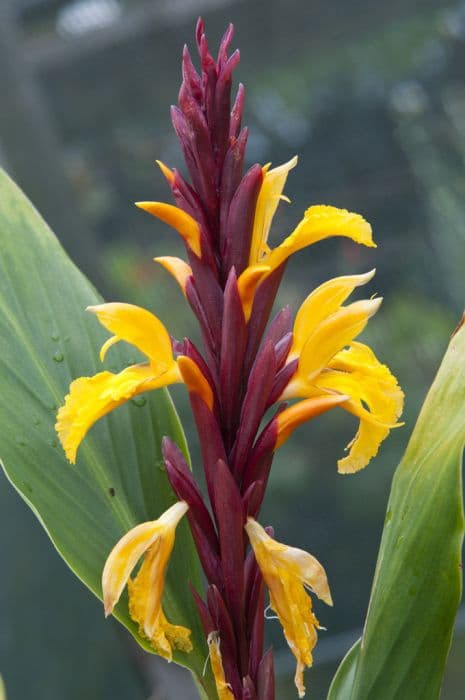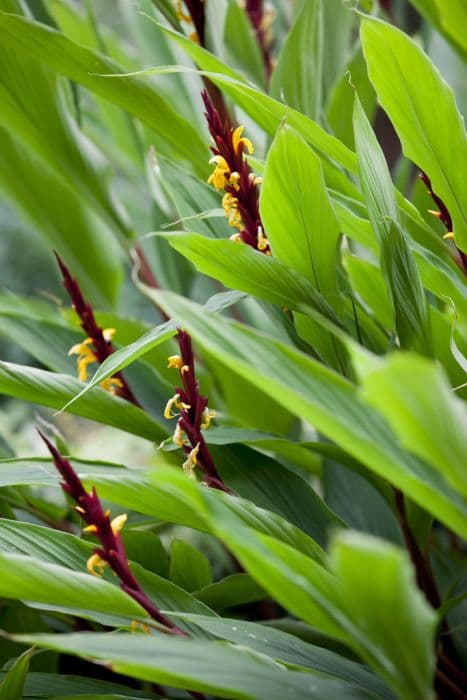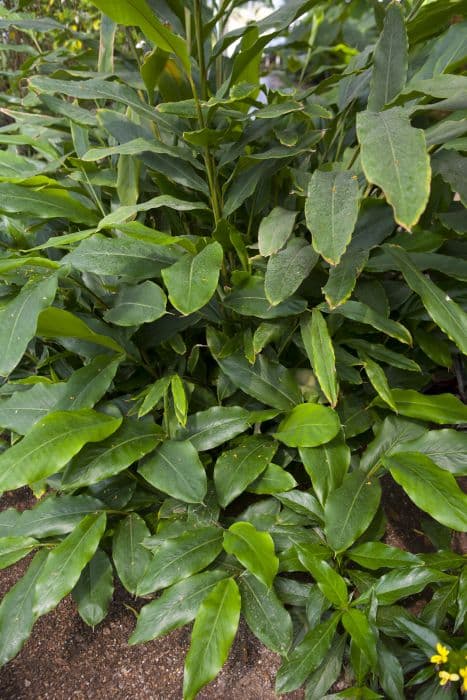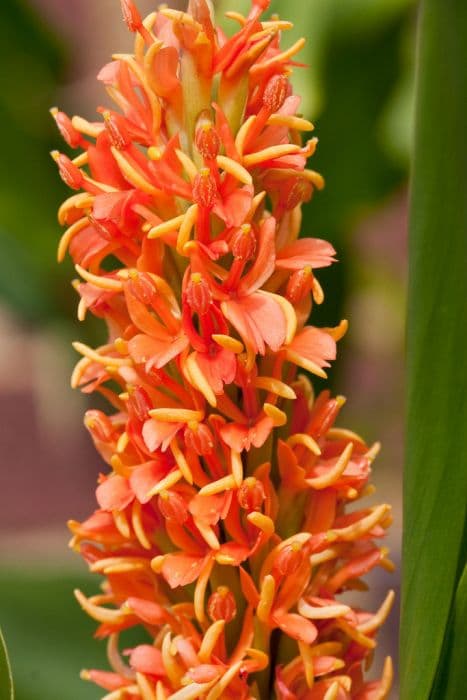Ginger Lily Hedychium densiflorum 'Stephen'

ABOUT
Hedychium densiflorum 'Stephen', commonly known as Hardy Ginger Lily, is a visually striking plant renowned for its ornamental appeal. The plant boasts lush, lance-shaped leaves that are a deep, glossy green. These leaves are arranged in a dense, clump-forming habit, creating an attractive, tropical-looking foliage mass. The most spectacular feature of Hardy Ginger Lily is its flower spikes, which are composed of tightly packed, small individual blooms. These flowers have a vibrant, fiery orange color that commands attention in any garden setting. The blossoms are typically arranged in a conical shape and emerge from the tops of the stems, offering a showy display that can last from mid-summer to early fall. Adding to the plant's allure, Hardy Ginger Lily flowers exude a delightful fragrance that can fill the surrounding air, making it a favorite among gardeners who appreciate sensory appeal. The overall impression of the Hardy Ginger Lily is one of lushness and exotic beauty, with its combination of striking flowers, aromatic scent, and full, verdant foliage creating an enchanting visual and olfactory experience.
About this plant
 Names
NamesFamily
Zingiberaceae.
Synonyms
Dense Ginger Lily, Orange Bottlebrush Ginger.
Common names
Hedychium densiflorum
 Toxicity
ToxicityTo humans
The plant commonly known as ginger lily, including Hedychium densiflorum 'Stephen', generally is not known to be toxic to humans. However, it is always advisable to exercise caution and not consume parts of ornamental plants unless they are known to be edible. If someone ingests a part of the plant and experiences negative symptoms, it is important to seek medical advice.
To pets
Ginger lily, specifically Hedychium densiflorum 'Stephen', does not have a notable record of toxicity to pets. However, it is always prudent to prevent pets from ingesting plants that are not known to be safe for consumption. If a pet does ingest any part of the plant and shows signs of illness, contacting a veterinarian would be advisable. Symptoms in pets from ingesting non-toxic plants can sometimes include mild gastrointestinal upset, such as vomiting or diarrhea.
 Characteristics
CharacteristicsLife cycle
Perennials
Foliage type
Deciduous
Color of leaves
Green
Flower color
Yellow
Height
4-6 feet (1.2-1.8 meters)
Spread
2-3 feet (0.6-0.9 meters)
Plant type
Bulb
Hardiness zones
8-11
Native area
Himalayas
Benefits
 General Benefits
General Benefits- Aesthetic Appeal: Hedychium densiflorum 'Stephen', commonly known as Ginger Lily, adds a tropical charm to gardens with its attractive, lush green foliage and vibrant orange-yellow flowers.
- Attracts Pollinators: The brightly colored flowers of the Ginger Lily attract a variety of pollinators including bees, butterflies, and hummingbirds, supporting local ecosystems.
- Fragrance: The Ginger Lily is known for its sweet, exotic fragrance which can enhance the sensory experience of a garden or outdoor space.
- Easy to Grow: This plant is recognized for its ease of cultivation, being adaptable to a range of soil types and tolerant of different light conditions.
- Garden Design Versatility: Ginger Lilies can be used in various garden design applications, such as part of tropical-themed gardens, in borders, or as a focal point due to their striking appearance.
- Fast Growth: Given the right conditions, Hedychium densiflorum 'Stephen' can grow quickly, allowing gardeners to establish an impressive display in a relatively short amount of time.
 Medical Properties
Medical Properties- Anti-inflammatory: Hedychium densiflorum 'Stephen' has been traditionally used to reduce inflammation.
- Antimicrobial: The plant contains compounds that have exhibited antimicrobial activity.
- Analgesic: It contains substances that have been used to alleviate pain.
- Antipyretic: The extracts of the plant may have been used to reduce fever.
- Gastroprotective: Some studies suggest that extracts from this plant could have a role in protecting the gastrointestinal tract.
 Air-purifying Qualities
Air-purifying QualitiesThis plant is not specifically known for air purifying qualities.
 Other Uses
Other Uses- Hedychium densiflorum 'Stephen', commonly known as Ginger Lily, can be used as a natural pest repellent, as some gardeners claim its scent deters pests from the garden.
- The robust and attractive foliage of Ginger Lily can be used in floral arrangements to add an exotic touch and texture.
- The fibrous stems of Ginger Lily might be explored for use in manufacturing paper or lightweight materials, although this is not a common practice.
- Ginger Lily's essential oils, if extracted, might be used in perfumery for their distinctive, spicy fragrance, although this is not a primary use for this plant.
- Due to their large and showy flowers, Ginger Lilies can be planted along pathways or borders as a natural wayfinding guide in gardens and parks.
- The dense root system of Ginger Lily can be helpful for soil stabilization in areas prone to erosion, such as slopes and riverbanks.
- When dried, the seed pods of Ginger Lily can be used in craft projects or as a decorative element in potpourri mixes.
- Ginger Lily can be used as a natural dye source, as certain plant parts may yield a colorant for fabrics or art projects.
- In some cultures, the flowers of Ginger Lily are used in ceremonies or traditional decorations for their symbolic meaning and appealing look.
- The plant can be a nectar source for pollinators, thus supporting local ecosystems and aiding in the conservation of bees and butterflies.
Interesting Facts
 Feng Shui
Feng ShuiThe plant_name is not used in Feng Shui practice.
 Zodiac Sign Compitability
Zodiac Sign CompitabilityThe plant_name is not used in astrology practice.
 Plant Symbolism
Plant Symbolism- Tropical Beauty: Hedychium densiflorum 'Stephen', commonly known as Ginger Lily, symbolizes exotic and tropical beauty due to its vibrant and attractive flowers, reminiscent of lush, tropical environments.
- Allure and Attraction: The fragrance and colorful appearance of Ginger Lily flowers often represent allure and attraction, making them a symbol of magnetism and charm in the plant world.
- Hospitality: In some cultures, Ginger Lilies may represent hospitality, as their inviting scent and appearance are thought to welcome guests warmly.
- Optimism and Strength: Thriving in warm climates and blooming with robust energy, Ginger Lily can symbolize optimism and the strength to overcome challenges.
- Wealth and Prosperity: Due to its lush and full blossoms, the Ginger Lily can be associated with wealth and prosperity, suggesting abundance in life.
 Water
WaterThe Ginger Lily requires consistent moisture during the growing season, so aim to water it once or twice a week, depending on weather conditions. On average, it should receive about 1 inch of water weekly either from rainfall or manual watering. When watering, soak the soil thoroughly to encourage deep root growth; this can be achieved by applying approximately half a gallon for smaller plants to a couple of gallons for larger, established clumps. During the winter months when the plant is dormant, reduce watering significantly to prevent rot.
 Light
LightThe Ginger Lily thrives in partial shade to full sun conditions. The ideal spot would provide bright, indirect sunlight for most of the day with some direct morning sun, which encourages flowering without causing scorching. Avoid placing it in deep shade or full afternoon sun, as this can hamper growth and bloom production.
 Temperature
TemperatureThe Ginger Lily prefers warm conditions and is hardy in USDA zones 7 through 10. It can tolerate temperatures as low as 0°F for short periods but thrives in temperatures ranging from 60°F to 80°F. To ensure optimal growth and flowering, protect the plant from frost and provide a warmer, sheltered location during the winter if necessary.
 Pruning
PruningPrune the Ginger Lily primarily to remove spent flowers and dead foliage, which encourages new growth and maintains a tidy appearance. The best time to prune is in late winter or early spring before new growth starts. Prune off the dead stems close to the ground annually, and throughout the growing season remove any damaged or diseased leaves as needed.
 Cleaning
CleaningAs needed
 Soil
SoilThe best soil mix for the Ginger Lily is well-draining, rich in organic matter, with a pH of 6.0 to 6.8. A mixture of loam, peat, and sand in equal parts is ideal to meet the plant's needs for moisture retention and proper drainage.
 Repotting
RepottingGinger Lily should be repotted every 2 to 3 years to refresh the soil and accommodate its growing root system. Larger containers may extend the time between repotting.
 Humidity & Misting
Humidity & MistingGinger Lily thrives in high humidity conditions, ideally between 60% to 80%. Maintaining such levels will support its lush growth and vibrant blooms.
 Suitable locations
Suitable locationsIndoor
Place in bright, indirect light with high humidity.
Outdoor
Provide partial shade and protect from cold, drying winds.
Hardiness zone
7-10 USDA
 Life cycle
Life cycleHedychium densiflorum 'Stephen', commonly known as the Ginger Lily, starts its life as a rhizomatous perennial, with its growth cycle beginning with the emergence of shoots from rhizomes in early spring. These shoots quickly develop into long, reed-like stems with lance-shaped leaves. As summer progresses, the plant produces dense, spike-like clusters of fragrant orange to yellow flowers at the top of each stem, which are attractive to pollinators. Following pollination, the flowers may produce capsules containing several seeds. In the fall, the above-ground portions of the plant die back with the onset of cooler temperatures, while the rhizomes survive underground, storing energy for the next growing season. Throughout winter, the rhizomes remain dormant until conditions are favorable again for growth in the following spring.
 Propogation
PropogationPropogation time
Spring-Early Summer
Hedychium densiflorum 'Stephen', commonly known as the ginger lily, is most effectively propagated through the division of rhizomes. This is typically done in late winter or early spring before new growth begins. To propagate by division, gardeners should carefully lift the clump of ginger lily from the ground and gently separate the rhizomes, ensuring that each section has at least one growth bud. The divisions are then planted in well-draining soil at the same depth they were growing previously, spaced about 18 inches (approximately 45.72 centimeters) apart to allow for ample growth. The soil should be kept moist, but not waterlogged, to encourage the new plants to establish.









